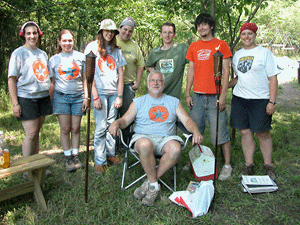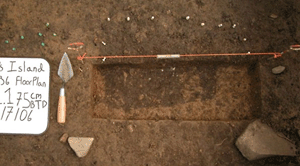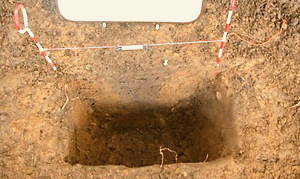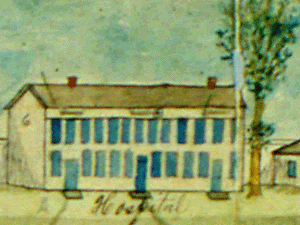The Heidelberg College Field School is now over, but we had a wonderful time exploring the prison hospital over the past few weeks. I still have several weeks of research yet ahead of me, so I am not done updating everyone on our experiences. Today, I will share a few of our findings that have not yet been covered in our updates. First, though, I thought I would provide a final picture of the field school crew. The students were so nice to provide some tikki torches to illuminate our lunch time discussions.
Our investigations have now proceeded to exploring the features that we have exposed in the subsoil. We have confirmed four post holes related to the prison hospital and one large pit containing brick and mortar. The first two pictures below show Feature 85, a post hole, during and after excavation. As you can see, there is a rectangular, dark stain where the post was probably placed. It measures about 20 centimeters long, or eight inches. This hole probably contained an eight inch post used to support the hospital structure.
The third picture below shows another post hole feature, Feature 87, where in addition to the eight inch post hole, there is mortar as well as part of the original post still projecting out. These post holes run about 25 centimeters below the plow zone; about 50 centimeters into the ground.
![[image]](https://interactive.archaeology.org/johnsons/gifs/field27.gif)
Feature 85 |
![[image]](https://interactive.archaeology.org/johnsons/gifs/field28.gif)
Feature 85 |
![[image]](https://interactive.archaeology.org/johnsons/gifs/field29.gif)
Feature 87 |
The post hole pictured to the left, Feature 88, is shown in the process of excavation. We are down about five centimeters below the subsoil, and as you can see, the outline of the disturbance is very clear. I suspect as we get deeper, another 20 centimeter post hole, or mold, will appear.
Of course, not all of our features turned out to be related to the prison hospital. You can see in the pictures how, on the surface, Feature 78 looks like another one of the square post holes. However, during the excavation, it turned out to be a root mold. This demonstrates why we need to fully excavate all of the features that we encounter.
Finally, we started to explore the larger brick and mortar feature, Feature 81. The first picture below shows how it appeared just at the subsurface interface. The second picture shows how half of the feature appeared just five centimeters below our starting point. As you can see, lots of bricks and a great deal of mortar appeared at this point. As we proceeded down another 2.5 centimeters, we removed much of the brick at that level and the mortar lens shrank. Several pieces of wood have been uncovered, but they appear to only be scraps that were thrown into this pit. I am still a bit perplexed about the purpose of this pit at this time.
![[image]](https://interactive.archaeology.org/johnsons/gifs/field33.gif)
Feature 81 |
![[image]](https://interactive.archaeology.org/johnsons/gifs/field34.gif)
Feature 81 |
![[image]](https://interactive.archaeology.org/johnsons/gifs/field35.gif)
Feature 81 |
As you can see from the historical drawing of the prison hospital, there were two chimneys on Block 6. We are excavating at the southern end of the hospital, near one of these locations. I suspect that somehow this pit relates to the chimney placement. Hopefully, as we get closer to the bottom of this feature this week, more will be revealed.
Well, that’s it for now. This week we have a teachers’ workshop at the site, so our next update should be very educational.






